May 18, 2025 | 14:42 GMT +7
May 18, 2025 | 14:42 GMT +7
Hotline: 0913.378.918
May 18, 2025 | 14:42 GMT +7
Hotline: 0913.378.918
Mr. Ngo Minh Long, Director of the Hau Giang Department of Agriculture and Rural Development, has just led a delegation to check the situation of saltwater intrusion in Vi Thanh city. In the suburban commune of Hoa Tien, the delegation inspected the work of preventing saltwater intrusion at the Kenh Lau sluice, which circulates with the Cai Lon River to flow into the West Sea through Rach Gia Bay (Kien Giang province).

Officers of the Hau Giang Sub-Department of Water Resources regularly measure salinity, update information, and warn people to proactively protect production. Photo: Trung Chanh.
According to actual measurement data by officers of the Hau Giang Sub-Department of Water Resources, salinity right at the outside sluice gate is 5.1‰ (g/l); salinity inside the fresh water retention area is 1.7‰.
On the Cai Lon River at the Kenh Lau river estuary, salinity is 5.4‰. Salinity at Kenh Lau sluice has continuously increased since the beginning of March, from 1.8‰ (March 1) to 5.1‰ (March 12), of which the highest level in the first 10 days of March is 5.9‰ (March 5). Also on the Cai Lon River at the Provincial Party Committee Base wharf (Thanh Thang hamlet, Hoa Tien commune), salinity measured on March 12 was 1.2‰.
Currently, in Vi Thanh city, there are 120 open sluices and underground sluices invested and built since 2000 to regulate water sources, prevent saltwater intrusion, and keep fresh water to protect production and people’s living standards.
Ms. Tran Thi Hoa Phuong, Standing Vice Chairwoman of Vi Thanh City People's Committee, said that in response to rising salinity and the risk of deep intrusion into interior fields, the city has proactively closed sluices to prevent saltwater intrusion and built temporary dams. At the same time, farmers are advised to collect and store water for production when salinity is still low, within the allowable limit. Therefore, as of now, the rice, vegetable, and fruit growing areas in the dike area have not been affected.
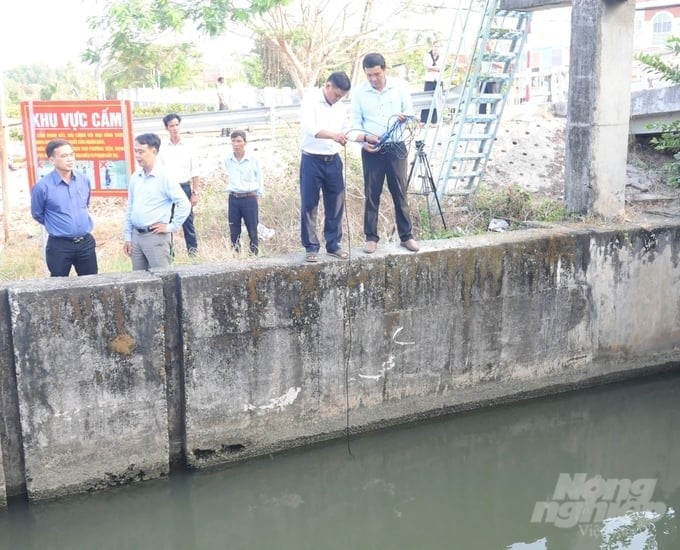
Officers of the Hau Giang Sub-Department of Water Resources measured the salinity at Kenh Lau sluice and recorded a continuous increase in salinity since the beginning of March. Photo: Trung Chanh.
As for domestic water, people in Vi Thanh city use domestic water provided by Hau Giang Water Supply and Sewerage-Projects Urban Joint Stock Company. Domestic water in suburban communes is provided by water supply stations of the Center for Clean Water and Rural Environmental Sanitation. Currently, the water source is still guaranteed; however, if saltwater intrusion prolongs and encroaches deeply into the river, the water source from the Tam Ngan area (upstream, bordering Chau Thanh A district) must be regulated to serve people.
Mr. Tran Thanh Toan, Director of the Hau Giang Sub-Department of Water Resources, said that saltwater intrusion into the province is increasing rapidly due to high tides in late January and early February. It is concerning that saltwater intrudes into the province in both directions, from the West Sea and the East Sea.
On the West Sea side (from Kien Giang direction), the highest salinity measured at Hoc Po sluice station (Luong Nghia commune, Long My district) is 9.5‰ (March 4), Luong Nghia Commune People's Committee of 8.7‰ (March 7), Nuoc Trong intersection (in Vi Thanh city) of 6.5‰ (March 5), and Nuoc Trong intersection (in Long My district) of 5.8‰ (March 5).
Saltwater from the East Sea (from Soc Trang province direction) intrudes into the Cai Con river with a salinity of 1.3‰ (March 11) and the Mai Dam river with a salinity of 0.6 ‰ (March 11), affecting the areas of Nga Bay city and Chau Thanh district.
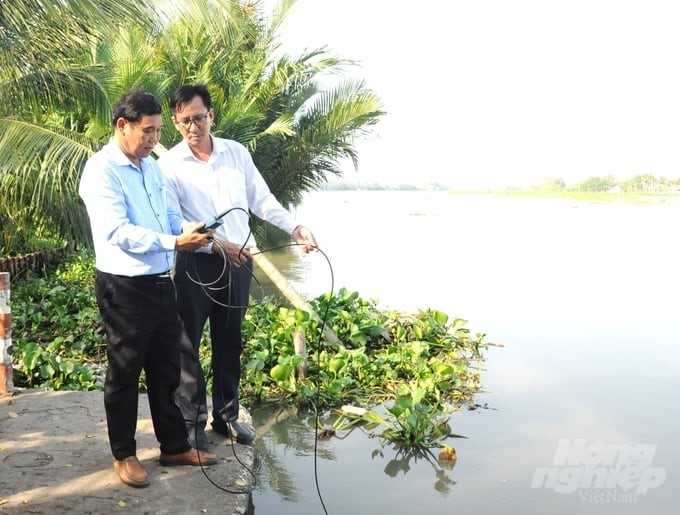
Mr. Ngo Minh Long (right), Director of the Hau Giang Department of Agriculture and Rural Development, directly together with officers of the Hau Giang Sub-Department of Water Resources, measures salinity on the Cai Lon River in Vi Thanh city and records the salinity that has been increasing highly in recent days. Photo: Trung Chanh.
According to Mr. Tran Thanh Toan, since the beginning of the dry season, the province’s functional sector has coordinated with the unit operating and exploiting irrigation structures at the provincial and district levels to close all sluices to prevent saltwater intrusion and ensure that saltwater does not penetrate into fields, affecting people's production. Along with that, disseminate information to people to raise awareness of drought and salinity prevention and control, and use production and domestic water economically.
With the severe drought and salinity situation, Hau Giang province estimates that about 90,000 hectares of land for rice, vegetable, and fruit production will likely be affected. Accordingly, upstream localities such as Chau Thanh district, Chau Thanh A district, and Nga Bay city will be affected by the drought. And downstream localities such as Vi Thanh city and Long My, Vi Thuy, and Phung Hiep districts are directly affected by saltwater intrusion.
Mr. Ngo Minh Long, Director of the Hau Giang Department of Agriculture and Rural Development, said that this year, drought and salinity affected Hau Giang province quite early. Saltwater intrusion with a recorded salinity of 3–4‰ appeared right after the Lunar New Year, was maintained, and has increased until now up to 7–9‰. Compared to the annual average, saltwater not only invades early but also at quite high levels.
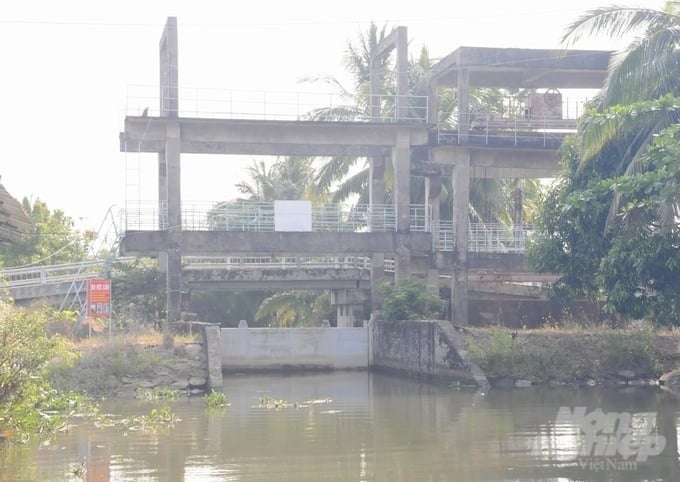
Hau Giang province has proactively closed all sluices to prevent saltwater intrusion and ensure that saltwater does not penetrate into fields, affecting people's production. Photo: Trung Chanh.
However, thanks to the regulation of the Cai Lon-Cai Be irrigation sluice system, saltwater intrusion into Hau Giang is being controlled from increasing too highly. Currently, although saltwater intrusion has not affected production, it has impacted people's living activities, especially the surface water source on some main rivers that people cannot use.
Saltwater can penetrate nearly 60 km deep on the Cai Lon-Cai Be river
According to forecasts, saltwater following West Sea tides may penetrate dozens of kilometers deep into the Cai Lon-Cai Be river in the next week.
Mr. Le Xuan Hien, Director of Kien Giang Provincial Hydro-Meteorological Station, said that saltwater intrusion is forecast from March 11–20. The highest salinity in the estuary area will tend to increase in the next 1-2 days due to rising water, then increase according to tides until March 13–16. The time of highest salinity during the day is from about 4 a.m. to 11 a.m.
If irrigation structures are not operated, on the Cai Be River, a salinity of 4‰ can intrude 18–20 km deep (at the beginning of Binh An commune, Chau Thanh district). The salinity of 1‰ penetrates about 24–26 km deep (near the end of Minh Hoa commune, Chau Thanh). On the Cai Lon River, 4‰ salinity penetrates about 48–52km deep (in the middle of Vinh Hoa Hung Nam commune, Go Quao district). The salinity of 1‰ intrudes about 55–57 km deep (at the end of Vinh Hoa Hung Nam commune, Go Quao).
On Cai San canal, salinity of 4‰ penetrates deep to Bau Thi bridge, Mong Tho commune, Chau Thanh district. 1‰ salinity penetrates deep into Chung Su bridge, Mong Tho B commune, Chau Thanh district. Notably, saltwater from the Cai Be River through Vam Ba Lich still intrudes strongly into the Cai San canal during high tide because the Vam Ba Lich lock has not been operated.
According to Mr. Hien, there is a warning of natural disaster risk levels due to saltwater intrusion, of which the Cai Be River and Cai San canal are at level 1, and the Cai Lon River at level 2. It is also warned that the impacts of saltwater intrusion on the Cai Lon River, Cai Be River, and Cai San canal increase highly during high tide during the day; salinity at 4‰ will have a strong impact on the growth of rice and crops and people's domestic water.
Translated by Huyen Vu Thu
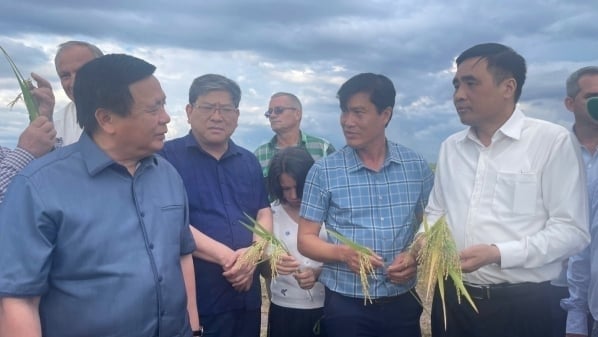
(VAN) Deputy Minister Nguyen Quoc Tri also expressed his hope that Cuba will soon overcome its current challenges, attain food security, and further expand cooperation with Vietnam.

(VAN) The project contributes to enhancing the resilience of communities vulnerable to the impacts of climate change, with a primary focus on local women.

(VAN) Green materials help save energy and resources. However, after more than 10 years, Vietnam has only developed over 200 green buildings with more than 6 million square meters of floor space.
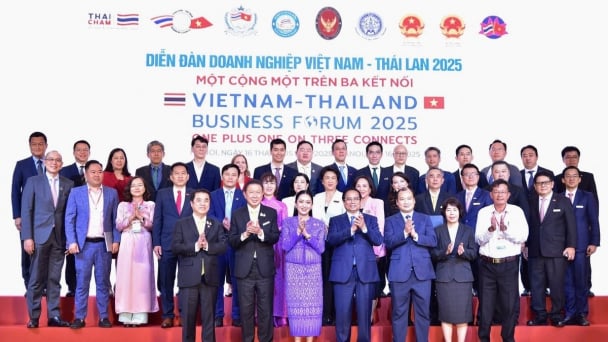
(VAN) Vietnam - Thailand Business Forum 2025: One plus one on three connects, marking a milestone in the comprehensive strategic partnership between the two nations.

(VAN) The United Nations designated 22 May as the International Day for Biodiversity 2025 with the theme 'Harmony with nature and sustainable development.'
![Multi-channel, multi-directional Vietnamese agricultural markets: [8] A national strategy is needed](https://t.ex-cdn.com/nongnghiepmoitruong.vn/608w/files/phucpm/2025/05/15/1435-thi-truong-nong-san-viet-da-kenh-da-huongbai-8-can-mot-chien-luoc-quoc-gia-084750_728.jpg)
(VAN) The Chairman of Hung Nhon Group shared: ‘Opening up and tapping into new markets is the right and strategic direction for Vietnam's agricultural sector.’

(VAN) Food waste has become a serious issue in modern society, especially in rapidly urbanizing and developing cities like Hanoi.